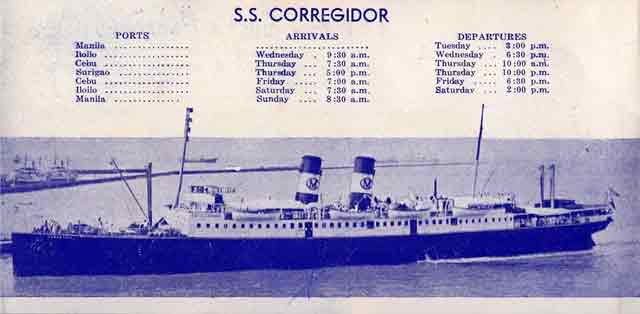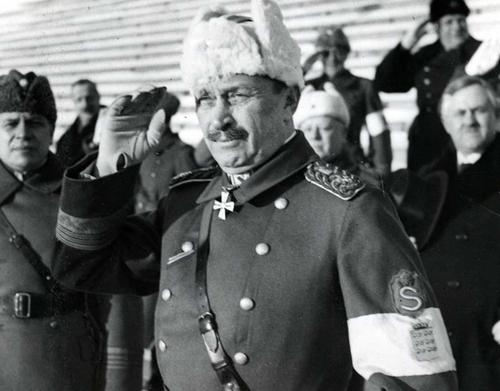Sunday 14 December 1941
 |
| "HMS EURYALUS (right) and HMS GALATEA on patrol with guns raised." This photo was taken on 14 December 1941 from the Naiad while on patrol in the Mediterranean. © IWM (A 7593). |
Eastern Front: Army Commander Field Marshal Walther von Brauchitsch continues his review of the Army Group Center forces around Moscow and receives very disquieting reports. He arrives at Roslavl to confer with Field Marshal von Kluge and General Guderian, who both urge further withdrawals. Unexpectedly, Hitler's chief adjutant, Generalmajor Rudolf Schmundt, arrives at the Army Group headquarters in Smolensk as a sort of personal representative for Hitler. Schmundt is a well-known glad-hander who has Hitler's complete confidence and communicates with him better than the generals. When von Brauchitsch returns to Smolensk in the afternoon, he tells Schmundt that he supports the army commanders' requests to retreat further. When Schmundt calls Hitler via General Jodl at OKW, however, Hitler refuses to grant any further withdrawals except for some minor adjustments in the line by Ninth Army and Third Panzer Army west of Kalinin and Klin and by Guderian's Second Panzer Army west of Tula.
 |
| "The cruisers HMS EURYALUS and GALATEA firing on enemy aircraft during an engagement" This photo is taken on 14 December 1941 from cruiser Naiad while on patrol in the Mediterranean. © IWM (A 7099). |
The entire affair illustrates a gradually growing assumption of direct control by Hitler over military operations. While Hitler has interfered in the past, these intrusions on the army's control have been relatively minor and "handled" by OKH Chief of Operations General Franz Halder and local commanders. The most notorious example to date of the local commanders ignoring Hitler's obvious wishes was the Army Group South withdrawal from Rostov-on-Don at the end of November. The general tactic heretofore has been to simply do what is considered necessary and present the moves to Hitler as a
fait accompli. However, by firing Field Marshal von Rundstedt on 1 December, Hitler indicated very strongly that he expects to be asked
before such moves are made from now on.
 |
| The Denver Post Home Edition, Sunday, December 14, 1941. "Hundreds Of [Japanese] 'Chutists Wiped Out In Hand-To-Hand Battle With Filipinos." Of course, there were no "' Chutists" and they certainly were not "wiped out." All of the war news is very reassuring. The Denver Post Library Archive. |
However, while Hitler realizes the need (in his view) for more direct control over the military, he is new to issuing direct operational orders. Hitler has not yet realized that he cannot leave any "wriggle room" for his subordinates to still issue orders contrary to his implied wishes. Today, his orders to Army Group Center explicitly state that while he does not now authorize "giving up any place or taking any evasive action," this could be acceptable once the army does "something" to prepare new lines to the rear. Von Bock and von Brauchitsch interpret this nebulous language to authorize a further retreat once they tell Hitler that they have a new defensive position in mind running along a line von Bock has visualized at Rzhev-Gzhatsk-Orel-Kursk. So, von Bock tells his army commanders to get ready for a further retreat once he placates Hitler. This, however, is not what Hitler really means, and thus a direct confrontation between Hitler and his army commanders is brewing.
 |
| The important things continue in the United States. This ticket would get you into the Chicago Bears vs. Green Bay Packers game in Wrigley Field on 14 December 1941. This is a Western Division playoff game. |
The Far North sector flares to life again when the Red Army attacks Finnish forces along the Svir River. They take the village of Gora, but the Finns stop further gains. While the Finns now refuse to take further offensive action, they are willing to fight hard to protect their current lines. Thus, Soviet attacks in this area in a sense serve the Germans' purposes, as they divert forces that could be used further south into pointless battles against Axis troops that otherwise would be idle. In fact, it is easy to speculate that this diversionary benefit of the Finnish forces is why Hitler does not put more effort into attaining a junction with the Finnish forces east of Leningrad.
 |
| The US media continues to mix facts with wildly optimistic but inaccurate reports on the fighting in the Pacific. For instance, the news from the Eastern Front flows along long-established channels and is reasonably accurate. However, the information chain from the new battles in the Pacific is sketchy at best. The headlines in the 14 December 1941 edition of the Syracuse Herald American illustrate this dichotomy nicely, reporting actual events in the Soviet Union but printing wild fantasies about supposed successes in the Philippines. |
Battle of the Pacific: The United States Navy begins its first offensive action of the war on 14 December 1941 when Vice Admiral Wilson Brown Jr.'s Task Force 11 sails toward Jaluit Atoll in the Marshall Islands. The mission is intended as a distraction for the Japanese as the embattled US Marines on Wake Island await relief. Meanwhile, the Japanese Navy sends two attacks early today against Wake Island by aircraft based in the Marshall Islands, including the first by "Mavis" flying boats and a later raid at 11:00 by Nell bombers based on Roi Island at Kwajalein. The second raid kills two US Marines and destroys one of the Marines' two remaining F4F-3 Wildcats. The Wake Island battle has become a media favorite, and from a public relations perspective is the most important campaign in the Pacific for the United States regardless of the fact that the island itself has little value to either side. Thus, the US Navy is planning a relief, but it is taking time to prepare.
 |
| Close-up of torpedo damage to U.S. Navy light cruiser USS Helena (CL-50) as seen in a dry dock of the Pearl Harbor Naval Shipyard on 14 December 1941. The cruiser was hit by a torpedo during the Pearl Harbor Attack on 7 December 1941. The original caption reads: "U.S.S. Helena - Torpedo damage between Frames 69 1/2 and 80 1/2 starboard side. Note propeller shaft, H.P. turbine to left. At right center floor plates were driven into teeth of a reduction gear by force of the explosion. Navy Yard, Pearl Harbor, T.H. (US Navy). |
On the Malay Peninsula, the British continue withdrawing more due to their own apprehensions than defeats inflicted by the Japanese. Area commander General Arthur Percival authorizes the 11th Indian Division on the west coast to withdraw south toward Singapore 30 miles (48 km) to a new line centered on the village of Gurun. The division's commander, Major-General Murray-Lyon, botches the retreat by failing to fully inform all of his units. This leaves many isolated men and units stranded, with no alert that everyone else around them is departing. Many of these men wind up being captured or overwhelmed by massive Japanese forces. In addition, there are few organized provisions made for crossing the Bata River, leading to many Allied troop drownings, lost equipment, and other calamities. Losses are much higher than necessary and the force is unnecessarily weakened as it tries to create a new line that has not been prepared. On the new line, the 11th Indian Division briefly attempts to block the Japanese just north of the village of Gurun, which has some natural features that favor the defense. After dark on the 14th, the Japanese - right on the heels of the retreating Commonwealth troops - make some penetrations into the new position.
 |
| The Michigan Daily of 14 December 1941 is full of news about the construction of new defense plants. This is where some would say World War II is actually won. |
On the east coast of the Malay Peninsula, the British Kelantan force continues a fighting withdrawal. The Indian 12th Brigade moves to the Baling region about nine miles west of Kroh. Due to the continuing British withdrawal, the defense of Penang Island becomes impossible. The British evacuate it, and Japanese forces occupy the island. Penang has a port that is well-stocked with ammunition and other stores.
 |
| Tarlac, Luzon railroad station after the Japanese bombing on December 14, 1941. |
In the Philippines, the Japanese advance in north Luzon. The Aparri force meets the Vigan force at Vigan. The two forces are placed under a combined command and prepare an advance to the Lingayen Gulf. The US Army Air Force sends its remaining B-17s of the Far East Air Force to bomb the new Japanese beachhead at Legaspi, and the bombers damage a freighter and tanker. Lieutenant Hewitt T. Wheless earns the DSC for this action when he nurses his damaged bomber back to a crash-landing at Cagayan, Mindanao Island. The US Navy sees how things are going overall despite this minor success and withdraws its remaining PBY Catalinas t of Patrol Wing Ten and accompanying tenders from the Philippines entirely.
 |
| "An Oerlikon gun crew in action on HMS NAIAD." This photo, taken on 14 December 1941, shows the Naiad while on patrol in the Mediterranean. © IWM (A 7594). |
Battle of the Mediterranean: In Libya, the battle of the Gazala line continues, but activity is light as both sides adjust their forces. The 5th New Zealand Brigade holds some hard-won penetrations into the line, and the British send the Polish Independent Brigade forward to reinforce them and plan further attacks for the 15th. A little to the south, the 7th Indian Infantry Brigade maintains the British line, while at Alem Hamza the 5th Indian Brigade mounts a failed attack. The Italian Ariete Division also mounts a minor attack with about a dozen tanks, but a motley collection of British units that includes an armored car squadron of the Central Indian Horse and the Royal East Kent Regiment beats them off. For the moment, a stalemate has developed all along the line, but Tobruk has been relieved and the main mission of Operation Crusader achieved.
 |
| Firemen battle a three-alarm fire at the Sanitary Public Market building, Pike Place Market, Seattle, December 14, 1941. While the fire's origins are unknown (and are never ascertained), speculation immediately leaps to Japanese saboteurs. (Courtesy MOHAI (PI22904)) |
December 1941December 1, 1941: Hitler Fires von RundstedtDecember 2, 1941: Climb Mount NiitakaDecember 3, 1941: Hints of Trouble in the PacificDecember 4, 1941: Soviets Plan CounteroffensiveDecember 5, 1941: Soviets Counterattack at KalininDecember 6, 1941: Soviet Counterattack at Moscow BroadensDecember 7, 1941: Japan Attacks Pearl HarborDecember 8, 1941: US Enters World War IIDecember 9, 1941: German Retreat At MoscowDecember 10, 1941: HMS Prince of Wales and Repulse SunkDecember 11, 1941: Hitler Declares War on USDecember 12, 1941: Japanese in BurmaDecember 13, 1941: Battle of Cape BonDecember 14, 1941: Hitler Forbids WithdrawalsDecember 15, 1941: The Liepaja MassacreDecember 16, 1941: Japan Invades BorneoDecember 17, 1941: US Military ShakeupDecember 18, 1941: Hitler Lays Down the LawDecember 19, 1941: Brauchitsch Goes HomeDecember 20, 1941: Flying Tigers in ActionDecember 21, 1941: The Bogdanovka MassacreDecember 22, 1941: Major Japanese Landings North of ManilaDecember 23, 1941: Wake Island Falls to JapanDecember 24, 1941: Atrocities in Hong KongDecember 25, 1941: Japan Takes Hong KongDecember 26, 1941: Soviets Land in the CrimeaDecember 27, 1941: Commandos Raid NorwayDecember 28, 1941: Operation Anthropoid BeginsDecember 29, 1941: Soviet Landings at FeodosiaDecember 30, 1941: Race for BataanDecember 31, 1941: Nimitz in Charge2020


















